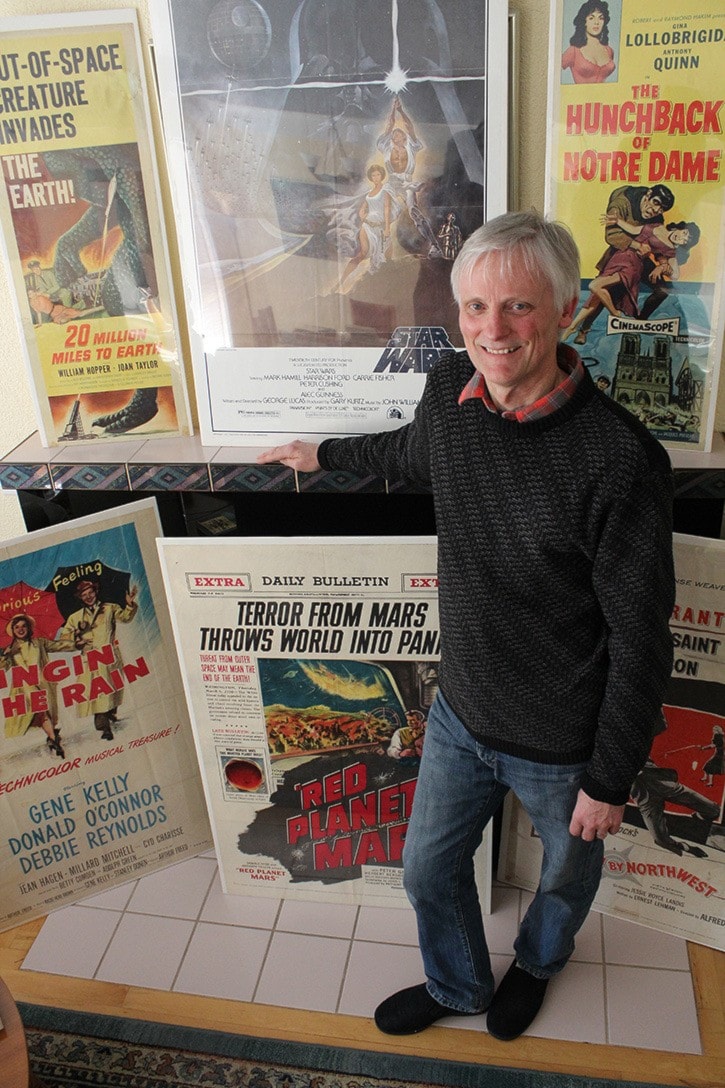You can hear the excitement in John Roger’s voice as he begins to talk about his favourite movies and, perhaps equally important to him, the posters used to advertise them.
Ranging from flamboyant, colourful artwork of spaceships and skeletons, to masterful portraits of Hollywood’s most recognizable stars, Roger’s collection is a window into a past age of film, when posters were hand drawn, before the era of Photoshop.
Known best as a Town of View Royal councillor, Rogers also has to his name an extensive and desirable collection of original movie posters dating as far back as the 1940s.
Rogers fascination with film began as a boy, watching movies with his parents, who were far from film buffs but enjoyed going to the movies.
“We used to sit and watch all these wonderful old movies. I got really intrigued with those old films that my parents liked,” Rogers said.
While attending the University of Victoria in the 1970s, Rogers was a regular at the on-campus cinema, now called Cinecenta, where he befriended one of the organizers. Rogers got to talking to him about movie posters and found out his peer could order them for $1.50 each.
It used to be when a movie came out the cinema would receive a series of posters, including a large one-sheet (27-by-41 inches, generally), half-sheets (22-by-28 inches) and lobby cards (typically 11-by-14 inches).
Rogers bought around 120 posters from this arrangement, a number which still makes up the bulk of his collection.
“Boxes would arrive on a regular basis…It was a really opportune time,” Rogers said.
Nowadays Rogers does his movie poster hunting primarily on eBay.
There are a number of factors which draw Rogers to a particular poster. The first element is the movie itself and Rogers is far more likely to buy a poster from a movie he is a particular fan of than simply collecting for its own sake. The poster artwork is another draw, with particularly eye-catching visuals, or unique elements, such as the day-glow orange font on the poster for Dr. Strangelove.
“When you’re a movie collector, it’s a personal thing. The test is, is it one of those films that whenever it’s on (TV), that no matter where it is in the film, you’re hooked?” Rogers said. “It’s just one level of tangible memories.”
One poster, an original for the 1975 thriller Jaws, has a personal connecting for Rogers, as he took his wife Maureen to see it on their first movie date, a choice of movie he somewhat regrets.
“She was black and blue from this film because I was grabbing hold of her,” Rogers said. “I really get thoroughly involved in movies.”
Affordability and storage considerations also enter into it. Rogers keeps all of his posters at a site other than his home.
Among the collection is a number of posters for science fiction and horror movies from the 1950s and ‘60s, known for colourful, outrageous artwork to capture a viewer’s attention. Among his collection is an original poster for 1958’s The Blob, the first film to feature Steve McQueen, and a gruesome one-sheet for the 1959 Vincent Price movie House on Haunted Hill.
Beyond those the collection ranges from the classic, including particularly high-valued posters for On the Waterfront and Singin’ in the Rain, to the foreign (Cries and Whispers, Bollywood film Umrao Jaan), to the mainstream (Star Wars), to the weird (SS Girls).
In 1993 the Victoria Art Gallery hosted an exhibit of Roger’s collection, showcasing dozens of his posters and filling a large gallery space with posters, lobby cards, books and memorabilia. Rogers is hoping to do the same again someday and is looking into opportunities at the art gallery and other locations.
